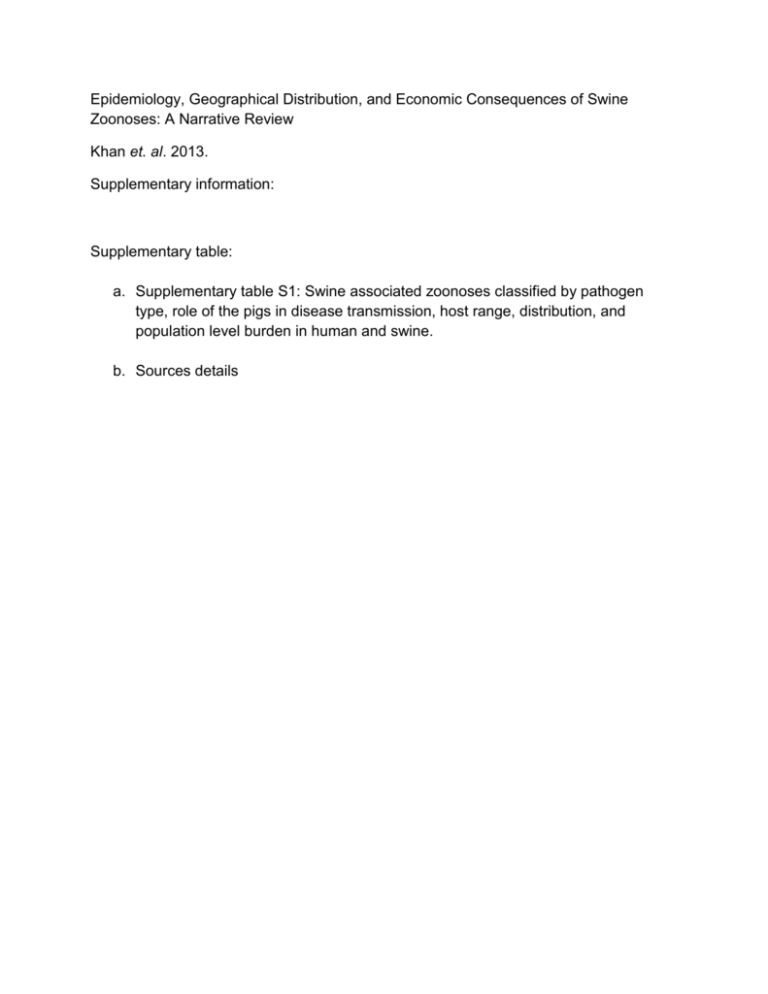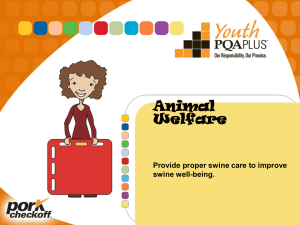Supplementary Table S1 (docx 348K)
advertisement

Epidemiology, Geographical Distribution, and Economic Consequences of Swine Zoonoses: A Narrative Review Khan et. al. 2013. Supplementary information: Supplementary table: a. Supplementary table S1: Swine associated zoonoses classified by pathogen type, role of the pigs in disease transmission, host range, distribution, and population level burden in human and swine. b. Sources details a. Supplementary table S1: Swine-associated zoonoses classified by pathogen type, role of the pigs in disease transmission, host range, distribution, population level disease burden in humans and swine, swine production loss, and occupational hazards. Pathogen type Pig’s role Primary animal host Other susceptible Distribution Human morbidity Human mortality Swine morbidity Swine mortality Swine production loss Occupational hazard Species Hepatitis E Hepatitis E virus Reservoir Pigs Wild boars, rhesus monkeys, humans Worldwide High Low Low No direct loss - 1-3 Hendra virus Hendra virus Susceptible Bats Horses, pigs, humans Australia High High in pregnant women High High Low - - 4, 5 Nipah virus Nipah virus Amplifier Bats Asia: Malaysia, Singapore, Bangladesh, and India High High Yes Swine workers Menangle virus Susceptible Bats Australia Moderate None Moderate to high High Low Menangle virus Pigs, goats, dogs, cats, humans Humans High Yes - Influenza virus A Influenza virus A Reservoir Mammals and birds - Worldwide Human, pigs - Worldwide - - Swine farmers/workers, laboratory workers - 13-20 Reservoir Moderate to high - Low/no Norwalk virus Low to moderate Low Low/no Norwalk virus Moderate to high High Reston ebola virus Reston ebola virus Susceptible Pigs USA, Philippine, Italy High High - - - Zaire ebola virus Susceptible Non-human primates Congo, Gabon, South Africa High High - - - Animal handlers at quarantine facilities - 25-28 Zaire ebola virus Human, non-human primates, bats Human, bats, pig Pathogen/disease Sources Emerging pathogens Viruses Bacteria 6-10 11, 12 21-24 26, 29-31 Staphylococcosis (LAMRSA infection) Staphylococcus aureus Reservoir Human Pig, veal calf, poultry Netherlands Germany Denmark Belgium, Italy, Portugal, Canada, and the United States Low Low Low Low No - 32-36 Streptococcal suis infection Streptococcus suis Reservoir Pigs Humans, boars, horses, dogs, cats The Netherlands, Denmark, Italy, Germany, Belgium, United Kingdom, France, Spain, Sweden, Ireland, Austria, Hungary, Hong Kong, Croatia, Japan, Singapore, Taiwan, New Zealand, Argentina, and United States Low High Low to moderate Low to moderate Yes - 2, 37, 38 Streptococcal porcinus infection Clostridium difficile Streptococcus porcinus Clostridium difficile Reservoir Pigs Humans Scandinavian countries, North America Low Moderate Low Low Low/no - 2, 39 Susceptible human Other mammals High Low Low Low Low - 2, 40 Melioidosis Burkholderia (Pseudomonas) pseudomallei Reservoir Pig, horse, sheep, goat, cattle, rodents, cats, and zoo animals - Tropical and sub-tropical regions, particularly in East Asia and Northern Australia High Low Moderate Low Low/no - 2, 38, 41-43 Pork tapeworm (Cysticercus cellulosae) Taenia solium Intermediate host Pigs, dogs - Central and South America, Central and Southern Africa, Southeast Asia, and Southern and Eastern Europe Moderate in endemic areas Low Moderate Low/no Yes Rural pig farmers and their families 38, 44-46 Giardiasis Giardia spp. Susceptible Cattle Pigs and other ruminants Worldwide: mostly in the tropics Moderate to high Low High Low - Agricultural workers 2, 38, 47 Japanese encephalitis virus Japanese encephalitis virus Reservoir Pigs, herons, egrets Human, ruminants, horses, domestic and wild avian Southeast Asia, particularly China and the Indian subcontinent High High High Low Yes - Pathogen/disease Species Pig’s role Primary animal host Other susceptible Distribution Human morbidity Human mortality Swine morbidity Swine mortality Swine production Occupational hazard Parasites Endemic pathogens Viruses Pathogen type 2, 7, 48, 49 Sources loss West Nile virus West Nile virus Susceptible Birds humans, pigs, ruminants, horses, and avian species Worldwide, particularly throughout Africa, parts of Europe, Middle East, West Asia, and Australia. New cases are reported in Greece, Israel, Romania, Russia, and in Americas it extends from Canada to Venezuela High Low Moderate Low/no - - 50-52 Vesicular stomatitis virus Vesicular stomatitis (VS) Indiana virus, VS Alagoas virus, VS New Jersey virus Swine vesicular disease Rotavirus A, C, E? Susceptible Cattle, equids, sheep, goats, and less frequently pigs Human Southern Mexico to northern South America (Colombia, Venezuela, Ecuador, and Peru), and United States High Rare - - Yes - 2, 38, 53 Reservoir Pigs Human Rare - Yes - Mice, rabbit, birds High Low Low Yes - 2, 56-62 Susceptible Birds, and insects Belgium, Italy , Greece, Cyprus, UK, Austria, and France Rare Rare High Low to high Low to high - 2, 38 Anthrax Encephalomyocarditis virus Bacillus anthracis Humans Worldwide Low Low Low Rare Yes - 2, 38, 63 Brucellosis Brucella suis Reservoir Human, pig, cattle, sheep, goat, horse, dog, cat Over 30 species of mammals including pigs Cattle, sheep, horses, other ungulates Domestic and feral pigs Moderate to high High Rare Reservoirs Enzootic in southern Italy, and sporadic in Europe, Asia, and North and South America Worldwide Worldwide High Low Low to high Low Yes - 2, 38, 64, 65 Campylobacter enteritis Campylobacter coli Reservoir Worldwide High Low Moderate Low Low/no - 2, 66-69 C. jejuni Reservoir Hamsters, guinea pigs, mice Worldwide High Low High Low Low/no - 2, 66-70 C. laridis Reservoir Hamsters, guinea pigs, mice Worldwide High Low Low Low Low/no - 2, 69, 71, 72 Q fever Coxiella burnetii Susceptible cattle, calves, sheep, zoo animals, dogs, cats cattle, calves, sheep, zoo animals, dogs, cats cattle, calves, sheep, zoo animals, dogs, cats sheep, goat, cattle, dogs Humans, cattle, horses, cattle, and dogs Hamsters, guinea pigs, mice Worldwide (except New Zealand) Moderate Low Rare - - - Post-weaning diarrhea and edema disease in piglets – entero-pathogenic, enterotoxigenic and edema disease Escherichia coli Erysipelas (diamond-skin disease) E. coli Susceptible Cattle, human Pigs, cats, other stray animals Pigs, other mammals Worldwide High Low Moderate to high Low to moderate Yes - Erysipelothrix rhusiopathiae Reservoir Swine, turkeys, pigeons, dolphin Sheep, and lambs Worldwide High (among occupationally exposed) Low High Low to moderate Yes 2, 79-82 Leptospiroses Leptospira spp. Reservoir Pigs Domestic and wild animals, common in rodents, dogs Worldwide High High High Low Yes Listeriosis Listeria monocytogenes Pasteurella multocida Reservoirs Cattle, sheep, pigs, dogs, cats, deer Cat, dog, pigs, guinea pig, rabbit, cattle, sheep Humans Worldwide High High High Low Yes Meat and meat product handlers; rendering-plant workers; veterinarians; game handlers; leather workers; and laboratory workers. Walking bare feet, divers, swimmers, canal workers, hunters travel through swamps, and jungles - Humans, other mammals Worldwide Moderate Low High High Yes 2, 38, 87 Salmonelloses Salmonella choleraesuis Reservoir Calves, pigs, poultry, wild birds, reptiles, and rodents Humans Worldwide High Low Low to high Low to moderate Yes Pathogen/disease Species Pig’s role Primary animal host Other susceptible Distribution Human morbidity Human mortality Swine morbidity Swine mortality Swine production Veterinarians, farmers, milkmen, and persons employed in areas where animal tissues are processed Animal dealers, animal keepers, butchers, sewage and canal workers, personals in food industries, and restaurants Occupational hazard Swine vesicular disease virus Rotavirus A Encephalomyocarditis virus Bacteria Pasteurellosis Pathogen type Reservoir Susceptible 38, 54, 55 73-75 2, 38, 76-78 2, 38, 83, 84 38, 85, 86 2, 38, 88 Sources loss Animal dealers, animal keepers, butchers, sewage and canal workers, food industry, and restaurant workers Hunters, butchers, farmers, fur/ wool handlers, veterinarians, laboratory workers Animal handlers, veterinarians, abattoir workers, hunters, raw meat processors 2, 38, 89 Yes Animal handlers, veterinarians, abattoir workers, hunters, raw meat processors 2, 38, 94-96 Low Yes Animal handlers, veterinarians, abattoir workers, hunters, raw meat processors 2, 38, 94-96 Low to high Low Low/no 2, 38, 97-101 High Low to high Low Low/no Hunters, shepherds, farmers, tourists in the endemic areas, veterinarians and cat owners Hunters, shepherds, farmers, tourists in the endemic areas, veterinarians and cat owners High Low Moderate Low to high Yes Swine workers, veterinarians 102-108 East and southeast Asia Moderate Low Moderate Low/no - - 38, 109-113 - Worldwide Low Low Low Low/no Low/no Veterinarians, swine farmers 2, 38, 114-118 Cattle, sheep, goat, rodents Pigs Worldwide Moderate Low Low Low/no Low/no Veterinarians, swine farmers 2, 38, 114-117 Susceptible Cats Worldwide Low Low/no No - 2, 38, 119-122 Reservoir Pigs Moderate to high Low to moderate Low Trichinella spp. Low Low to moderate Low Yes - 2, 38, 123 Chinese liver fluke Clonorchis sinensis Reservoir Pigs, cat, dog Low - - 38, 124, 125 Reservoir Pigs Low - Children under the age of 15 38, 126-132 Gastrodiscoides hominis Reservoir Pigs, mouse, deer, field rats, and rhesus monkeys - Low or moderate Moderate to high Moderate to high Low/no Gastrodiscoidiasis Low to moderate Low to moderate Moderate to high Low Fasciolopsis buski Low/no - - Schistosomiasis (bilharziasis) Schistosoma japonicum Susceptible Buffaloes and cattle Goats, horses, pigs, rats and dogs Parts of east Asia; eastern Siberia, Japan, the Republic of Korea, China, Taiwan, and Vietnam. Sporadic cases in Malaysia, Singapore and the Philippines China, Taiwan, Thailand, Vietnam, Laos, Cambodia, Bangladesh, India, Indonesia, and Malaysia India, Pakistan, Myanmar, Vietnam, the Philippines, Thailand, China, Kazakhstan, Indian immigrants in Guyana, and the Volga Delta in Russia Southeast Asia, China, Philippines Low Giant intestinal fluke Domestic, game, and other wild animals Dog, sheep, goats, wild boars, bears, badgers, and nutrias Species of cyprinoid fish, snail Young rabbits Moderate to high Low Low Low/no - 38, 139, 140 Cystic echinococcosis; Hydatid disease; Hydatidosis Echinococcus granulosus Intermediate host Sheep, cattle, and cervid Pigs, camels, other mammals Worldwide but mostly in Mediterranean region and southern South America Low Yes Species Pig’s role Primary animal host Other susceptible Distribution Low to moderate Swine morbidity Low/no Pathogen/disease Moderate to high Human morbidity Persons engaged in fishing and agricultural activities requiring contact with water - Swine mortality Swine production Occupational hazard Sources Salmonelloses Salmonella enteritidis Reservoir Calves, pigs, poultry, wild birds, reptiles, and rodents Humans Worldwide High Low Low to high Low to moderate Yes Tularemia Francisella tularensis Susceptible Humans North America and Eurasia High Moderate to high High High Low/no Mycobacterium avium Complex (Tuberculosis) Mycobacterium avium Susceptible Sheep, dogs, pigs, horses, multiple species of wild mammals Many species of mammals, some birds Worldwide High Low Low Low Yes M. tuberculosis Susceptible Cattle, farmed buffalo, goats, wild mammals Worldwide High Low Low Low M. bovis Susceptible Cattle, farmed buffalo, goats, wild mammals Worldwide High Low Low Yersinia enterocolitica Susceptible Rodents Humans, wild mammals particularly deer and wild boars Humans, pigs, cats, dogs, horses and sheep and other mammals Humans, pigs, cats, dogs, horses and sheep and other mammals Humans, domestic and wild mammals Worldwide High Low Yersinia pseudotuberculosis Susceptible Rodents Humans, domestic and wild mammals High Reservoir Multiple domestic animals including dogs, cats, and cattle Cattle, pig Raindeer and wild felids - Cryptosporidiasis Mycoplasma suis (Eperythrozoon suis) Taenia saginata asiatica Cryptosporidium suis Asia (Vietnam, China, Mongolia, Kazakhstan, India, and Myanmar), Africa (East Central Africa, Uganda, Tanzania, Zambia, The Domestic Republic of Congo, Libya, and Madagascar), United States in North America, and South America (Brazil, Bolivia, Peru, and Ecuador) Worldwide Pigs Susceptible Toxoplasmosis Cryptosporidium parvum Toxoplasma gondii Trichinellosis Yersiniases (plague) Mycoplasma suis Parasites Pathogen type Asian taeniasis Intermediate host Susceptible Worldwide Human mortality 38, 90-92 2, 38, 93 2, 38 133-138 38, 141-145 loss Entamoeba polecki Reservoir Pigs, wild boars, and monkeys - Worldwide, particularly in Southeast Asia Low Low Moderate Low/no No Rural pig farmers and their families 3, 23, 146-151 Influenza virus B Influenza virus B Susceptible Human Seals Worldwide Low Low Low Low Negligible - 2, 38, 152 Influenza virus C Influenza virus C Worldwide Low Low Low Low Negligible - 2, 21, 38 Suid Herpesvirus 1 Suid herpesvirus 1 Primary host cattle, sheep, goats, dogs, cats, foxes in fur farms, rats, and wild mice Humans - - High High Yes - 15, 16 Henipa like viruses Henipa like viruses Susceptible Pig - South America, Europe, and Asia. In Europe, PRV (Pseudorabies virus) has never been reported in Norway, Finland, or Malta. PRV has been eradicated from Germany, Austria, Sweden, Denmark, and the United Kingdom. Canada, New Zealand, and the United States. Ghana, Bangladesh - - High Low - - 153, 154 Pasteurellosis Pasteurella aerogenes Susceptible Humans, other mammals Europe Rare Low Low Low Low/no Pig farmers 2, 155, 156 Clostridium tetani Clostridium tetani Susceptible Cat, dog, pigs, guinea pig, rabbit, cattle, sheep All farmed animals: cattle, pig, lambs. and dogs, and cats - Worldwide Low High Low High Yes Farm and abattoir workers, veterinarians 2, 63, 157, 158 Dermatophytosis (Ringworm) Microsporum nanum Reservoir Pigs - Worldwide Low Low Low/no No No 2, 38, 159-161 M. canis Susceptible Cat, dog, horse All mammals North and South America, Europe, and Africa Low Low Low/no No No M. gypseum Susceptible All mammals - Worldwide Low Low Low/no No No Trichophyton mentagrophytes T. rubrum Susceptible Rodents All mammals Worldwide Low Low Low/no No No Susceptible Dogs, cattle, pigs - Worldwide Low Low Low/no No No Animal handlers, pet owners, veterinarians Animal handlers, pet owners, veterinarians Animal handlers, pet owners, veterinarians Animal handlers, pet owners, veterinarians Animal handlers, pet owners, veterinarians Animal handlers, pet owners, veterinarians Backyard pig farmers 19, 23, 146, 163- Entamoebiasis Sporadically occurring pathogens Viruses Bacterial Fungal Parasitic Balantidiasis Sarcosporidiasis Susceptible Human - T. verrucosum Susceptible Cattle, other ruminants All mammals Worldwide Low Low Low/no No No Balantidium coli Reservoir Pigs Wild boars, rabbits, rats, monkeys, and primates - Worldwide; endemic in People's Republic of China, Philippines, Indonesia, Japan, the south Pacific islands, Brazil, Peru, Panama, and Cuba Worldwide; highly prevalent in Indian subcontinent Moderate to high Low to high Low High Low/no - Sarcocystis suihominis * Some of the fields are blank due to lack of data. Intermediate host Humans, chimpanzees, and rhesus and cynomolgus monkeys 2, 18, 38, 159 2, 38, 159, 162 2, 38, 159, 162 2, 17, 38, 159, 162 2, 38, 159, 162 167 Low Low to high Low Low/no - 2, 38, 146, 168170 b. Source details (references for supplementary table) 1. Yazaki Y, Mizuo H, Takahashi M et al. Sporadic acute or fulminant hepatitis E in Hokkaido, Japan, may be food-borne, as suggested by the presence of hepatitis E virus in pig liver as food. J Gene Virol 2003; 84: 2351-7. 2. Zimmerman J, Karrier L, Ramirez A, Schwartz K, Stevenson G (eds.) Diseases of Swine. 10th ed. Ames: Blackwell Publishing, 2012. 3. Chacin-Bonilla L. Entamoeba polecki infection in Venezuela. Report of a new case. Trans R Soc Trop Med Hyg 1983; 77: 137. 4. Lewthwaite P, Solomon T. Response to Hossain and Others: Hospital-Based Surveillance for Japanese Encephalitis at Four Sites in Bangladesh, 2003-2005. Am J Trop Med Hyg 2010; 83: 445. 5. Li MY, Embury-Hyatt C, Weingartl HM. Experimental inoculation study indicates swine as a potential host for Hendra virus. Vet Res 2010; 41: 33. 6. Roberts MC, Soge OO, No D, Beck NK, Meschke JS. Isolation and characterization of methicillinresistant Staphylococcus aureus from fire stations in two northwest fire districts. Am J Infect Control 2011; 39: 382-389. 7. Erlanger TE, Weiss S, Keiser J, Utzinger J, Wiedenmayer K. Past, Present, and Future of Japanese Encephalitis. Emerg Infect Dis 2009; 15: 1-7. 8. Hills SL, Phillips DC. Past, Present, and Future of Japanese Encephalitis. Emerg Infect Dis 2009; 15: 1333. 9. Hsu VP, Hossain MJ, Parashar UD et al. Nipah virus encephalitis reemergence, Bangladesh. Emerg Infect Dis 2004; 10: 2082-2087. 10. Hossain MJ, Gurley ES, Montgomery S et al. Response to Hossain and Others: Hospital-Based Surveillance for Japanese Encephalitis at Four Sites in Bangladesh, 2003-2005 Response. Am J Trop Med Hyg 2010; 83: 446. 11. Chant K, Chan R, Smith M, Dwyer DE, Kirkland P. Probable human infection with a newly described virus in the family Paramyxoviridae. The NSW Expert Group. Emerg Infect Dis 1998; 4: 273275. 12. Philbey AW, Kirkland PD, Ross AD et al. An apparently new virus (family Paramyxoviridae) infectious for pigs, humans, and fruit bats. Emerg Infect Dis 1998; 4: 269-271. 13. Shinde V, Bridges CB, Uyeki TM et al. Triple-reassortant swine influenza A (H1) in humans in the United States, 2005-2009. N Engl J Med 2009; 360: 2616-2625. 14. Centers for Disease Control and Prevention. Parasites - Onchocerciasis (also known as River Blindness). Atlanta: CDC, 2013. Available at: http://www.cdc.gov/parasites/onchocerciasis/ (25 January 2013) 15. Tischer BK, Osterrieder N. Herpesviruses--a zoonotic threat? Vet Microbiol 2010; 140: 266-270. 16. Baskerville A, McFerran JB, C. D. Aujeszyky’s disease in pigs. Vet Bull (London) 1973; 43: 465–80. 17. Monga DP, Mohapatra LN. A compilation of published reports of mycoses in animals in India. Mycopathologia 1980; 72: 3-11. 18. Aly R. Ecology and epidemiology of dermatophyte infections. J Ame Acad of Dermatol 1994; 31: S21-S25. 19. Owen IL. Parasitic zoonoses in Papua New Guinea. J helminthol 2005; 79: 1-14. 20. Myers KP, Olsen CW, Setterquist SF et al. Are swine workers in the United States at increased risk of infection with zoonotic influenza virus? Clin Infect Dis 2006; 42: 14-20. 21. Guo YJ, Jin FG, Wang P, Wang M, Zhu JM. Isolation of influenza C virus from pigs and experimental infection of pigs with influenza C virus. J Gen Virol 1983; 64 (Pt 1): 177-182. 22. Patel MM, Widdowson MA, Glass RI, Akazawa K, Vinje J, Parashar UD. Systematic literature review of role of noroviruses in sporadic gastroenteritis. Emerg Infect Dis. 2008; 14(8): 1224-31. 23. Solaymani-Mohammadi S, Rezaian M, Hooshyar H, Mowlavi GR, Babaei Z, Anwar MA. Intestinal protozoa in wild boars (Sus scrofa) in western Iran. J Wildl Dis. 2004; 40(4): 801-3. 24. WHO/Diarrhoeal Diseases (Updated February 2009). February 2009 [cited 7/29/11]; Available from: http://www.who.int/vaccine_research/diseases/diarrhoeal/en/index1.html 25. Barrette RW, Metwally SA, Rowland JM, Xu L, Zaki SR, Nichol ST, et al. Discovery of swine as a host for the Reston ebolavirus. Science (New York, NY. 2009; 325(5937): 204-6. 26. Cui S, Li J, Hu C, Jin S, Li F, Guo Y, et al. Isolation and characterization of methicillin-resistant Staphylococcus aureus from swine and workers in China. J Antimicrob Chemother. 2009; 64(4): 680-3. 27. Hartmeyer GN, Gahrn-Hansen B, Skov RL, Kolmos HJ. Pig-associated methicillin-resistant Staphylococcus aureus: Family transmission and severe pneumonia in a newborn. Scand J Infect Dis. 2010; 42(4): 318-20. 28. Khanna T, Friendship R, Dewey C, Weese JS. Methicillin resistant Staphylococcus aureus colonization in pigs and pig farmers. Vet Microbiol. 2008; 128(3-4): 298-303. 29. Horikawa K, Murakami K, Kawano F. Isolation and characterization of methicillin-resistant Staphylococcus aureus strains from nares of nurses and their gowns. Microbiol Res. 2001; 155(4): 345-9. 30. Kobinger GP, Leung A, Neufeld J, Richardson JS, Falzarano D, Smith G, et al. Replication, Pathogenicity, Shedding, and Transmission of Zaire ebolavirus in Pigs. J Infect Dis. 2011; 204(2): 200-8. 31. Weingartl HM, Embury-Hyatt C, Nfon C, Leung A, Smith G, Kobinger G. Transmission of Ebola virus from pigs to non-human primates. Sci Rep. 2012; 2: 811. 32. Iwao Y, Yabe S, Takano T, Higuchi W, Nishiyama A, Yamamoto T. Isolation and molecular characterization of methicillin-resistant Staphylococcus aureus from public transport. Microbiol Immunol. 2012; 56(1): 76-82. 33. Roberts MC, Soge OO, No D, Beck NK, Meschke JS. Isolation and characterization of methicillinresistant Staphylococcus aureus from fire stations in two northwest fire districts. Am J Infect Control. 2011; 39(5): 382-9. 34. Cui SH, Li JY, Hu CQ, Jin SH, Li FQ, Guo YC, et al. Isolation and characterization of methicillinresistant Staphylococcus aureus from swine and workers in China. J Antimicrob Chemoth. 2009; 64(4): 680-3. 35. Pu SH, Han FF, Ge BL. Isolation and Characterization of Methicillin-Resistant Staphylococcus aureus Strains from Louisiana Retail Meats. Appl Environ Microb. 2009; 75(1): 265-7. 36. Pu S, Han F, Ge B. Isolation and characterization of methicillin-resistant Staphylococcus aureus strains from Louisiana retail meats. Appl Environ Microbiol. 2009; 75(1): 265-7. 37. Deschamps JY, Roux FA, Sai P, Gouin E. History of xenotransplantation. Xenotransplantation. 2005; 12(2): 91-109. 38. Krauss H. WA, Appel M., Enders B., Isenberg H.D., Schiefer H.G., Slenczka W., von Graevenitz A., Zahner H., editor. Zoonoses: Infectious Diseases Transmissible from Animals to Humans. 3rd ed. Washington DC: ASM Press; 2003. 39. Pappas G, Markoula S, Seitaridis S, Akritidis N, Tsianos E. Brucellosis as a cause of carpal tunnel syndrome. Ann Rheum Dis. 2005; 64(5): 792-3. 40. Balassiano IT, Yates EA, Domingues RMCP, Ferreira EO. Clostridium difficile: a problem of concern in developed countries and still a mystery in Latin America. J Med Microbiol. 2012; 61(2): 16979. 41. White NJ. Melioidosis. Lancet. 2003; 361(9370): 1715-22. 42. Choy JL, Mayo M, Janmaat A, Currie BJ. Animal melioidosis in Australia. Acta Trop. 2000; 74(2-3): 153-8. 43. Limmathurotsakul D, Thammasart S, Warrasuth N, Thapanagulsak P, Jatapai A, Pengreungrojanachai V, et al. Melioidosis in Animals, Thailand, 2006-2010. Emerging Infectious Diseases. 2012; 18(2): 325-7. 44. MVM. Global zoonoses. The merck Veterinary Manual. 2011 [cited 2013 30 January]; Available from: http://www.merckvetmanual.com/mvm/servlet/CVMHighLight?file=htm/bc/tzns01.htm&word=Taenia 45. Garcia HH, Del Brutto OH. Taenia solium cysticercosis. Infect Dis Clin North Am. 2000; 14(1): 97119, ix. 46. Héctor H García, Armando E Gonzalez, Carlton AW Evans, Gilman RH. Taenia solium cysticercosis. http://dx.doi.org/10.1016/S0140-6736(03)14117-7. The Lancet. 2003; 362(9383): 547–56. 47. Atwill ER, Sweitzer RA, Pereira MG, Gardner IA, Van Vuren D, Boyce WM. Prevalence of and associated risk factors for shedding Cryptosporidium parvum oocysts and Giardia cysts within feral pig populations in California. Appl Environ Microbiol. 1997; 63(10): 3946-9. 48. Solomon T. Control of Japanese encephalitis--within our grasp? N Engl J Med. 2006; 355(9): 86971. 49. Hossain MJ, Gurley ES, Montgomery S, Petersen L, Sejvar J, Fischer M, et al. Hospital-Based Surveillance for Japanese Encephalitis at Four Sites in Bangladesh, 2003-2005. Am J Trop Med Hyg. 2010; 82(2): 344-9. 50. Murgue B, Zeller H, Deubel V. The ecology and epidemiology of West Nile virus in Africa, Europe and Asia. Curr Top Microbiol Immunol. 2002; 267: 195-221. 51. Campbell GL, Marfin AA, Lanciotti RS, Gubler DJ. West Nile virus. Lancet Infect Dis. 2002; 2(9): 519-29. 52. Ratho RK, Sethi S, Prasad SR. Prevalence of Japanese encephalitis and West Nile viral infections in pig population in and around Chandigarh. J Commun Dis. 1999; 31(2): 113-6. 53. Federer KE, Burrows R, Brooksby JB. Vesicular stomatitis virus - the relationship ship between some strains of the Indiana serotype. Res Vet Sci. 1967; 8: 103 -17. 54. Lin F, Mackay DKJ, Knowles NJ. The persistence of swine vesicular disease virus infection in pigs. Epidemiol Infect. 1998; 121(2): 459-72. 55. OIE. Swine vesicular disease. World Organization for Animal Health. 2012 [cited 20 December 2012]; Available from: http://www.oie.int/fileadmin/Home/eng/Animal_Health_in_the_World/docs/pdf/SWINE_VESICULAR_D ISEASE_FINAL.pdf 56. Martella V, Banyai K, Matthijnssens J, Buonavoglia C, Ciarlet M. Zoonotic aspects of rotaviruses. Vet Microbiol. 2010; 140(3-4): 246-55. 57. Cunliffe NA, Dove W, Bunn JE, Ben Ramadam M, Nyangao JW, Riveron RL, et al. Expanding global distribution of rotavirus serotype G9: detection in Libya, Kenya, and Cuba. Emerg Infect Dis. 2001; 7(5): 890-2. 58. Parashar UD, Hummelman EG, Bresee JS, Miller MA, Glass RI. Global illness and deaths caused by rotavirus disease in children. Emerg Infect Dis. 2003; 9(5): 565-72. 59. Santos N, Lima RC, Nozawa CM, Linhares RE, Gouvea V. Detection of porcine rotavirus type G9 and of a mixture of types G1 and G5 associated with Wa-like VP4 specificity: evidence for natural human-porcine genetic reassortment. J Clin Microbiol. 1999; 37(8): 2734-6. 60. Steele AD, Ivanoff B. Rotavirus strains circulating in Africa during 1996-1999: emergence of G9 strains and P[6] strains. Vaccine. 2003; 21(5-6): 361-7. 61. Winiarczyk S, Paul PS, Mummidi S, Panek R, Z. G. Survey of porcine rotavirus G and P genotype in Poland and the United States using RT-PCR. J Vet Med B Infect Dis Vet Public Health. 2002; 49(8): 373-8. 62. Desselberger U, Iturriza-Go´mara M, G J. Rotavirus epidemiology and surveillance. In: Chadwick D, JA G, editors. Gastroenteritis viruses. New York: Willey; 2001. p. 82-100. 63. Beran GW. Handbook of Zoonoses, Second Edition, Section a: Bacterial, Rickettsial, Chlamydial, and Mycotic Zoonoses: CRC Press; 1994. 64. Gresham CS, Gresham CA, Duffy MJ, Faulkner CT, Patton S. Increased prevalence of Brucella suis and pseudorabies virus antibodies in adults of an isolated feral swine population in coastal South Carolina. J Wildlife Dis. 2002; 38(3): 653-6. 65. Ruiz-Fons F, Segales J, Gortazar C. A review of viral diseases of the European wild boar: Effects of population dynamics and reservoir role. Vet J. 2008; 176(2): 158-69. 66. Gebreyes WA, Thakur S, Morrow WEM. Campylobacter coli: prevalence and antimicrobial resistance in antimicrobial-free (ABF) swine production systems. J Antimicrob Chemoth. 2005; 56(4): 765-8. 67. Jensen AN, Dalsgaard A, Baggesen DL, Nielsen EM. The occurrence and characterization of Campylobacter jejuni and C. coli in organic pigs and their outdoor environment. Vet Microbiol. 2006; 116(1-3): 96-105. 68. Oporto B, Esteban JI, Aduriz G, Juste RA, Hurtado A. Prevalence and strain diversity of thermophilic campylobacters in cattle, sheep and swine farms. J Appl Microbiol. 2007; 103(4): 977-84. 69. Nachamkin I., Szymanski C.M., J. BM. Campylobacter, 2nd Ed., Edited by I. Nachamkin and M. J. Blaser. American Society for Microiology. Washington, DC: ASM Press; 2008. 70. Boes J, Nersting L, Nielsen EM, Kranker S, Enoe C, Wachmann HC, et al. Prevalence and diversity of Campylobacter jejuni in pig herds on farms with and without cattle or poultry. J Food Protect. 2005; 68(4): 722-7. 71. Rosef O, Kapperud G, Lauwers S, Gondrosen B. Serotyping of Campylobacter-Jejuni, Campylobacter-Coli, and Campylobacter-Laridis from Domestic and Wild Animals. Appl Environ Microb. 1985; 49(6): 1507-10. 72. Broczyk A, Thompson S, Smith D, Lior H. Water-Borne Outbreak of Campylobacter LaridisAssociated Gastroenteritis. Lancet. 1987; 1(8525): 164-5. 73. Lang G. Coxiellosis (Q fever) in animals. In: TJ M, editor. Q fever, the disease. Boca Raton: CRC Press; 1990. p. 23-48. 74. Sommamoreira RE, Caffarena RM, Somma S, Perez G, Monteiro M. Analysis of Q-Fever in Uruguay. Rev Infect Dis. 1987; 9(2): 386-7. 75. Clark RK, Jessup DA, Hird DW, Ruppanner R, Meyer ME. Serologic survey of California wild hogs for antibodies against selected zoonotic disease agents. J Am Vet Med Assoc. 1983; 183(11): 1248-51. 76. Milnes AS, Stewart I, Clifton-Hadley FA, Davies RH, Newell DG, Sayers AR, et al. Intestinal carriage of verocytotoxigenic Escherichia coli O157, Salmonella, thermophilic Campylobacter and Yersinia enterocolitica, in cattle, sheep and pigs at slaughter in Great Britain during 2003. Epidemiol Infect. 2008; 136(6): 739-51. 77. Tauxe RV. Emerging foodborne pathogens. Int J Food Microbiol. 2002; 78(1-2): 31-41. 78. Zhao CW, Ge BL, De Villena J, Studler R, Yeh E, Zhao SH, et al. Prevalence of Campylobacter spp., Escherichia coli, and Salmonella serovars in retail chicken, turkey, pork, and beef from the Greater Washington, DC, area. Appl Environ Microb. 2001; 67(12): 5431-6. 79. Wood RL, RD S. Erysipelothrix infection. In Infectious Diseases of Wild Mammals, 2d ed. JW Davis, LH Karstad, D O Trainer, eds. pp. 297–305. Ames: Iowa State Univ Press. 1981. 80. Ewald F. The genus Erysipelothrix. In: Starr MP, Stolp H, Triiper HG, Balows A, Schlegel HG (eds) The prokaryotes: a handbook on habitats, isolation, and identification of bacteria, Vol 2. New York, Springer-Verlag.; 1981. 81. Brooke CJ, Riley TV. Erysipelothrix rhusiopathiae: bacteriology, epidemiology and clinical manifestations of an occupational pathogen. J Med Microbiol. 1999; 48(9): 789-99. 82. Hoffmann CW, Bilkei G. Case study: Chronic erysipelas of the sow - a subclinical manifestation of reproductive problems. Reprod Domest Anim. 2002; 37(2): 119-20. 83. Bharti AR, Nally JE, Ricaldi JN, Matthias MA, Diaz MM, Lovett MA, et al. Leptospirosis: a zoonotic disease of global importance. Lancet Infect Dis. 2003; 3(12): 757-71. 84. Dutta TK, Christopher M. Leptospirosis--an overview. J Assoc Physicians India. 2005; 53: 545-51. 85. Ramaswamy V, Cresence VM, Rejitha JS, Lekshmi MU, Dharsana KS, Prasad SP, et al. Listeria-review of epidemiology and pathogenesis. J Microbiol Immunol Infect. 2007; 40(1): 4-13. 86. Thevenot D, Dernburg A, Vernozy-Rozand C. An updated review of Listeria monocytogenes in the pork meat industry and its products. J Appl Microbiol. 2006; 101(1): 7-17. 87. Kristinsson G. Pasteurella multocida infections. Pediatr Rev. 2007; 28(12): 472-3. 88. Wales AD, Cook AJ, Davies RH. Producing Salmonella-free pigs: a review focusing on interventions at weaning. Vet Rec. 2011; 168(10): 267-76. 89. Fosse J, Seegers H, Magras C. Prevalence and Risk Factors for Bacterial Food-Borne Zoonotic Hazards in Slaughter Pigs: A Review. Zoonoses Public Hlth. 2009; 56(8): 429-54. 90. University IS. Tularemia. The Center for Food Security and Public Health, and Institutes for International Cooperation in Animal Biologics of Iowa State University. 2009 [cited 2012 June 26]; Available from: http://www.cfsph.iastate.edu/Factsheets/pdfs/tularemia.pdf 91. Hubalek Z, Treml F, Juricova Z, Hunady M, Halouzka J, Janik V, et al. Serological survey of the wild boar (Sus scrofa) for tularaemia and brucellosis in South Moravia, Czech Republic. Vet Med-Czech. 2002; 47(2-3): 60-6. 92. Merck Veterinery Manual. Tularemia. 2011 [cited 16 February 2013]; Available from: http://www.merckvetmanual.com/mvm/index.jsp?cfile=htm/bc/52400.htm 93. OIE. Avian Tuberculosis. OIE Terrestrial Manual 2009. Chapter: 2.3.6. 2008 [cited 16 February 2013]; Available from: http://www.oie.int/fileadmin/Home/eng/Health_standards/tahm/2.03.06_AVIAN_TB.pdf 94. OIE. Bovine Tuberculosis. OIE Terrestrial Manual 2009. Chapter: 2.4.7. 2009 [cited; Available from: 95. Biet F, Boschiroli ML, Thorel MF, Guilloteau LA. Zoonotic aspects of Mycobacterium bovis and Mycobacterium avium-intracellulare complex (MAC). Veterinary research. 2005; 36(3): 411-36. 96. Tschopp R, Aseffa A, Schelling E, Berg S, Hailu E, Gadisa E, et al. Bovine tuberculosis at the wildlife-livestock-human interface in Hamer Woreda, South Omo, Southern Ethiopia. PLoS One. 5(8): e12205. 97. Gurtler M, Alter T, Kasimir S, Linnebur M, Fehlhaber K. Prevalence of Yersinia enterocolitica in fattening pigs. J Food Prot. 2005; 68(4): 850-4. 98. Christensen SG. Yersinia enterocolitica in Danish pigs. The Journal of applied bacteriology. 1980; 48(3): 377-82. 99. Drummond N, Murphy BP, Ringwood T, Prentice MB, Buckley JF, Fanning S. Yersinia enterocolitica: a brief review of the issues relating to the zoonotic pathogen, public health challenges, and the pork production chain. Foodborne pathogens and disease. 2012; 9(3): 179-89. 100. Falcao JP, Brocchi M, Proenca-Modena JL, Acrani GO, Correa EF, Falcao DP. Virulence characteristics and epidemiology of Yersinia enterocolitica and Yersiniae other than Y. pseudotuberculosis and Y. pestis isolated from water and sewage. J Appl Microbiol. 2004; 96(6): 1230-6. 101. Fenwick SG, Wauters G, Ursing J, Gwozdz M. Unusual Yersinia enterocolitica strains recovered from domestic animals and people in New Zealand. FEMS Immunol Med Microbiol. 1996; 16(3-4): 241-5. 102. Barker EN, Tasker S, Day MJ, Warman SM, Woolley K, Birtles R, et al. Development and use of real-time PCR to detect and quantify Mycoplasma haemocanis and "Candidatus Mycoplasma haematoparvum" in dogs. Vet Microbiol. 2010; 140(1-2): 167-70. 103. Hoelzle LE. Haemotrophic mycoplasmas: recent advances in Mycoplasma suis. Vet Microbiol. 2008; 130(3-4): 215-26. 104. Hofmann-Lehmann R, Meli ML, Dreher UM, Gonczi E, Deplazes P, Braun U, et al. Concurrent infections with vector-borne pathogens associated with fatal hemolytic anemia in a cattle herd in Switzerland. J Clin Microbiol. 2004; 42(8): 3775-80. 105. Messick JB. Hemotrophic mycoplasmas (hemoplasmas): a review and new insights into pathogenic potential. Veterinary clinical pathology / American Society for Veterinary Clinical Pathology. 2004; 33(1): 2-13. 106. Stoffregen WC, Alt DP, Palmer MV, Olsen SC, Waters WR, Stasko JA. Identification of a haemomycoplasma species in anemic reindeer (Rangifer tarandus). J Wildl Dis. 2006; 42(2): 249-58. 107. Willi B, Filoni C, Catao-Dias JL, Cattori V, Meli ML, Vargas A, et al. Worldwide occurrence of feline hemoplasma infections in wild felid species. J Clin Microbiol. 2007; 45(4): 1159-66. 108. Yuan CL, Liang AB, Yao CB, Yang ZB, Zhu JG, Cui L, et al. Prevalence of Mycoplasma suis (Eperythrozoon suis) infection in swine and swine-farm workers in Shanghai, China. American journal of veterinary research. 2009; 70(7): 890-4. 109. Chao D, Fan PC, Liu HY, Lee KM, WC C. Taenia saginata (?) among Taiwan aborigines is probably a new species. Chin J Microbiol. 1979; 12: 108–9. 110. Chan CH, Fan PC, Chung WV, Chen YA, Wu CC, Hsu MC, et al. Studies on taeniasis in Taiwan. I. Prevalence of taeniasis among aborigines in Wulai District, Taipei County, northern Taiwan. Proceed 1st Sino-American Symp. 1987: 65-77. 111. Eom KS, Rim HJ. Morphologic descriptions of Taenia asiatica sp. n. The Korean journal of parasitology. 1993; 31(1): 1-6. 112. Eom KS, Jeon HK, Rim HJ. Geographical distribution of Taenia asiatica and related species. The Korean journal of parasitology. 2009; 47 Suppl: S115-24. 113. Eom K. What is Asian Taenia? Parasitology International. 2006; 55: S137 – S41. 114. Tyzzer EE. A sporozoon found in the peptic glands of the common mouse. Proc Soc Exp Biol Med 1907; 5: 12-3. 115. Mosier D, Oberst R. Cryptosporidiosis. A global challenge. Annals of the New York Academy of Sciences. 2000; 916: 102-11. 116. Tzipori S, Angus KW, Campbell I, Gray EW. Cryptosporidium: evidence for a single-species genus. Infection and immunity. 1980; 30(3): 884-6. 117. Zintl A, Proctor AF, Read C, Dewaal T, Shanaghy N, Fanning S, et al. The prevalence of Cryptosporidium species and subtypes in human faecal samples in Ireland. Epidemiol Infect. 2009; 137(2): 270-7. 118. Pohjola S, Oksanen H, Jokipii L, Jokipii AM. Outbreak of cryptosporidiosis among veterinary students. Scand J Infect Dis. 1986; 18(2): 173-8. 119. Nicolle C, Manceaux L. Sur une infection aÁ corps de Leishman (ou organismes voisins) du gondi. C R Hebd SeÂances Acad Sci. 1908: 147:763±6. 120. Tenter AM, Heckeroth AR, Weiss LM. Toxoplasma gondii: from animals to humans. Int J Parasitol. 2000; 30(12-13): 1217-58. 121. Dubey J, Beattie C. Toxoplasmosis of Animals and Man. Boca Raton, FL: CRC Press; 1988. 122. Hill D, Dubey JP. Toxoplasma gondii: transmission, diagnosis and prevention. Clin Microbiol Infect. 2002; 8(10): 634-40. 123. Pozio E. World distribution of Trichinella spp. infections in animals and humans. Vet Parasitol. 2007; 149(1-2): 3-21. 124. Conlan JV, Sripa B, Attwood S, Newton PN. A review of parasitic zoonoses in a changing Southeast Asia. Vet Parasitol. 2011; 182(1): 22-40. 125. Schistosomes, liver flukes and Helicobacter pylori. IARC Working Group on the Evaluation of Carcinogenic Risks to Humans. Lyon, 7-14 June 1994. IARC monographs on the evaluation of carcinogenic risks to humans / World Health Organization, International Agency for Research on Cancer. 1994; 61: 1-241. 126. Malviya HC. The susceptibility of mammals to Fasciolopsis buski. Journal of helminthology. 1985; 59(1): 19-22. 127. Chai JY, Shin EH, Lee SH, Rim HJ. Foodborne intestinal flukes in Southeast Asia. The Korean journal of parasitology. 2009; 47 Suppl: S69-102. 128. Cook GC. George Busk, FRS (1807-1886): surgeon, zoologist, parasitologist and palaeontologist. Transactions of the Royal Society of Tropical Medicine and Hygiene. 1996; 90(6): 715-6. 129. Lun ZR, Gasser RB, Lai DH, Li AX, Zhu XQ, Yu XB, et al. Clonorchiasis: a key foodborne zoonosis in China. Lancet Infect Dis. 2005; 5(1): 31-41. 130. Roy B, Tandon V. Seasonal prevalence of some zoonotic trematode infections in cattle and pigs in the north-east montane zone in India. Vet Parasitol. 1992; 41(1-2): 69-76. 131. Weng YL, Zhuang ZL, Jiang HP, Lin GR, Lin JJ. [Studies on ecology of Fasciolopsis buski and control strategy of fasciolopsiasis]. Zhongguo ji sheng chong xue yu ji sheng chong bing za zhi = Chinese journal of parasitology & parasitic diseases. 1989; 7(2): 108-11. 132. Crompton DWT, Montresor A, Nesheim MC, Savioli L. Controlling diseases due to Helminth infection. World Health Organization; 2004. 133. Yu S-H, E. K. Epidemiology and morbidity of food-borne intestinal trematode infections. World Health Organization. Technical document. 1994 [cited 07 March 2013]; Available from: http://apps.who.int/iris/bitstream/10665/61103/1/WHO_SCHISTO_94.108.pdf 134. Maji AK, Bera DK, Manna B, Nandy A, Addy M, Bandyopadhyay AK. First record of human infection with Echinostoma malayanum in India. Transactions of the Royal Society of Tropical Medicine and Hygiene. 1993; 87(6): 673. 135. Beaver P, Jung R, Cupp E, editors. Clinical Parasitology. 9th ed. ed. Philadelphia, USA: Lea & Febiger; 1984. 136. Mas-Coma S, Bargues MD, Valero MA. Fascioliasis and other plant-borne trematode zoonoses. Int J Parasitol. 2005; 35(11-12): 1255-78. 137. Armon R, Cheruti U. Environmental Aspects of Zoonotic Diseases: IWA Publishing; 2012. 138. Fayer R. Cryptosporidium: a water-borne zoonotic parasite. Vet Parasitol. 2004; 126(1-2): 37-56. 139. Zou FC, Dong GD, Yang JF, Xie YJ, Zhang YG, Duan G, et al. Prevalences of Schistosoma japonicum infection in reservoir hosts in south-western China. Annals of tropical medicine and parasitology. 2010; 104(2): 181-5. 140. Li YS, Sleigh AC, Ross AG, Williams GM, Tanner M, McManus DP. Epidemiology of Schistosoma japonicum in China: morbidity and strategies for control in the Dongting Lake region. Int J Parasitol. 2000; 30(3): 273-81. 141. Ammann RW, Eckert J. Cestodes. Echinococcus. Gastroenterology clinics of North America. 1996; 25(3): 655-89. 142. CDC. Parasites - Echinococcosis. Centers for Disease Control and Prevention. 2012 [cited 07 March 2013]; Available from: http://www.cdc.gov/parasites/echinococcosis/epi.html 143. Schantz P, J. Chai, Craig P. Epidemiology and control of hydatid disease. In Thompson RCA, Lymbery A (eds): Echinococcus and Hydatid Disease. Wallingford, Oxon, UK, CAB International. 1995: 223. 144. Bruzinskaite R, Sarkunas M, Torgerson PR, Mathis A, Deplazes P. Echinococcosis in pigs and intestinal infection with Echinococcus spp. in dogs in southwestern Lithuania. Vet Parasitol. 2009; 160(34): 237-41. 145. Torgerson PR, Dowling PM. Estimating the economic effects of cystic echinococcosis. Part 2: an endemic region in the United Kingdom, a wealthy, industrialized economy. Annals of tropical medicine and parasitology. 2001; 95(2): 177-85. 146. Solaymani-Mohammadi S, Petri WA, Jr. Zoonotic implications of the swine-transmitted protozoal infections. Vet Parasitol. 2006; 140(3-4): 189-203. 147. Gay JD, Abell TL, Thompson JH, Jr., Loth V. Entamoeba polecki infection in Southeast Asian refugees: multiple cases of a rarely reported parasite. Mayo Clinic proceedings. 1985; 60(8): 523-30. 148. Desowitz RS, Barnish G. Entamoeba polecki and other intestinal protozoa in Papua New Guinea Highland children. Annals of tropical medicine and parasitology. 1986; 80(4): 399-402. 149. Giboda M, Vokurkova N, Kopacek P, Ditrich O, Gutvirth J. Entamoeba polecki: morphology, immunology, antigen study and clinic of the first infections in Czechoslovakia. Folia parasitologica. 1988; 35(1): 11-6. 150. Sargeaunt P, Williams J, Neal R. A comparative study of Entamoeba histolytica (NIH :200, HK9, etc.), "E. histolytica-like" and other morphologically identical amoebae using isoenzyme electrophoresis. Trans R Soc Trop Med Hyg. 1980; 74(4): 469-74. 151. Pakandl M. The prevalence of intestinal protozoa in wild and domestic pigs. Vet Med (Praha). 1994; 39(7): 377-80. 152. Osterhaus AD, Rimmelzwaan GF, Martina BE, Bestebroer TM, Fouchier RA. Influenza B virus in seals. Science (New York, NY. 2000; 288(5468): 1051-3. 153. Hayman DT, Wang LF, Barr J, Baker KS, Suu-Ire R, Broder CC, et al. Antibodies to henipavirus or henipa-like viruses in domestic pigs in Ghana, West Africa. PLoS One. 2011; 6(9): e25256. 154. Khan MS, Gary Crameri, Emily S. Gurley, M. Jahangir Hossain, Lin-Fa Wang, Luby SP. Serological evidence of Nipah like viral infection in pigs in Bangladesh. American Society of Tropical Medicine and Hygiene. Atlanta, GA; 2012. 155. Fodor L, Hajtos I, Glavits R. Abortion of a sow caused by Pasteurella aerogenes. Acta veterinaria Hungarica. 1991; 39(1-2): 13-9. 156. Ejlertsen T, Gahrn-Hansen B, Sogaard P, Heltberg O, Frederiksen W. Pasteurella aerogenes isolated from ulcers or wounds in humans with occupational exposure to pigs: a report of 7 Danish cases. Scand J Infect Dis. 1996; 28(6): 567-70. 157. Carle A, Rattone G. Studio eperimentale sull'eziologia del tetano. Giorn Accad Med Torino. 1984; 32: 174–9. 158. Kitasato S. Experimentelle Untersuchungen uber das Tetanusgift. Z Hyg Infektkr. 1891; 10: 267305. 159. Chermette R, Ferreiro L, Guillot J. Dermatophytoses in animals. Mycopathologia. 2008; 166(5-6): 385-405. 160. Fuentes CA. A new species of Microsporum. Mycologia. 1956; 48: 613-4. 161. Morganti L, Bianchedi M, Ajello L, Padhye A. First European report of swine infection by Microsporum nanum. Mycopathologia. 1976; 59(3): 179-82. 162. Philpot CM. Geographical distribution of the dermatophytes: a review. The Journal of hygiene. 1978; 80(2): 301-13. 163. Esteban JG, Aguirre C, Angles R, Ash LR, Mas-Coma S. Balantidiasis in Aymara children from the northern Bolivian Altiplano. Am J Trop Med Hyg. 1998; 59(6): 922-7. 164. Yazar S, Altuntas F, Sahin I, Atambay M. Dysentery caused by Balantidium coli in a patient with non-Hodgkin's lymphoma from Turkey. World J Gastroenterol. 2004; 10(3): 458-9. 165. Damriyasa IM, Bauer C. Prevalence and age-dependent occurrence of intestinal protozoan infections in suckling piglets. Berliner und Munchener tierarztliche Wochenschrift. 2006; 119(7-8): 28790. 166. Krascheninnikow S, Jeska EL. Agar diffusion studies on the species specificity of Balantidium coli, B. caviae and B. wenrichi. Immunology. 1961; 4: 282-8. 167. Hindsbo O, Nielsen CV, Andreassen J, Willingham AL, Bendixen M, Nielsen MA, et al. Agedependent occurrence of the intestinal ciliate Balantidium coli in pigs at a Danish research farm. Acta Vet Scand. 2000; 41: 79–83. 168. Fayer R. Sarcocystis spp. in human infections. Clinical microbiology reviews. 2004; 17(4): 894902, table of contents. 169. Bussiéras J. [An example of holozoonosis: human coccidiosis due to Sarcocystis spp]. Bull Acad Natl Med 1994 1994; Apr;178(4):613-22; discussion 622-3. 170. Avapal RS, Sharma JK, Juyal PD. Pathological changes in Sarcocystis infection in domestic pigs (Sus scrofa). Vet J. 2004; 168(3): 358-61.





